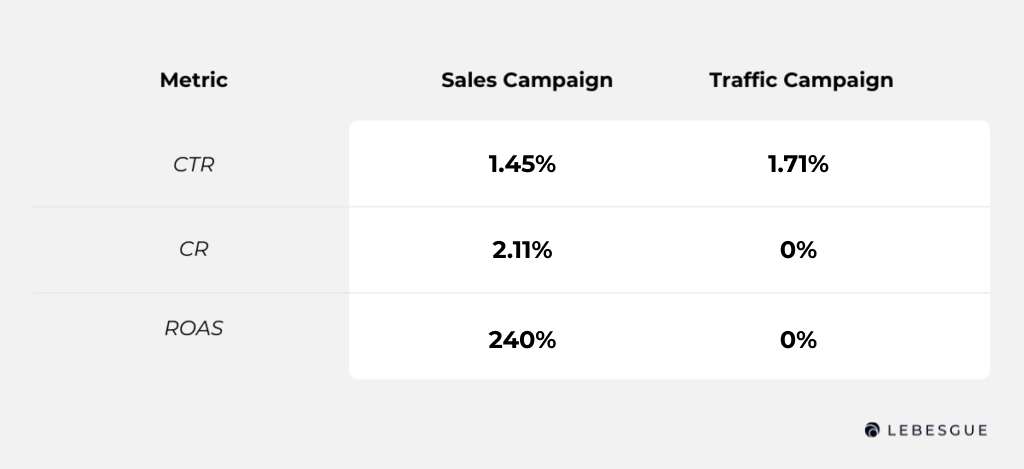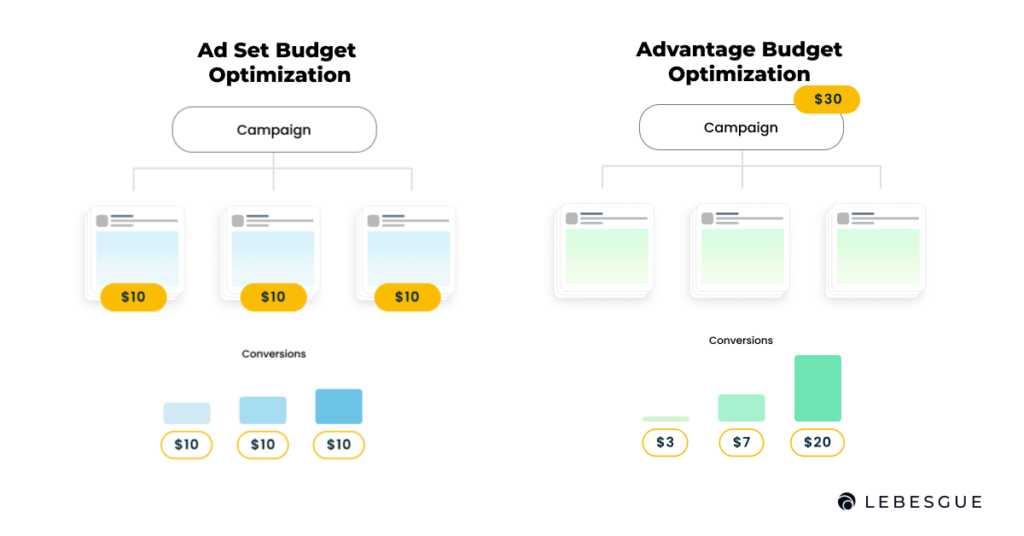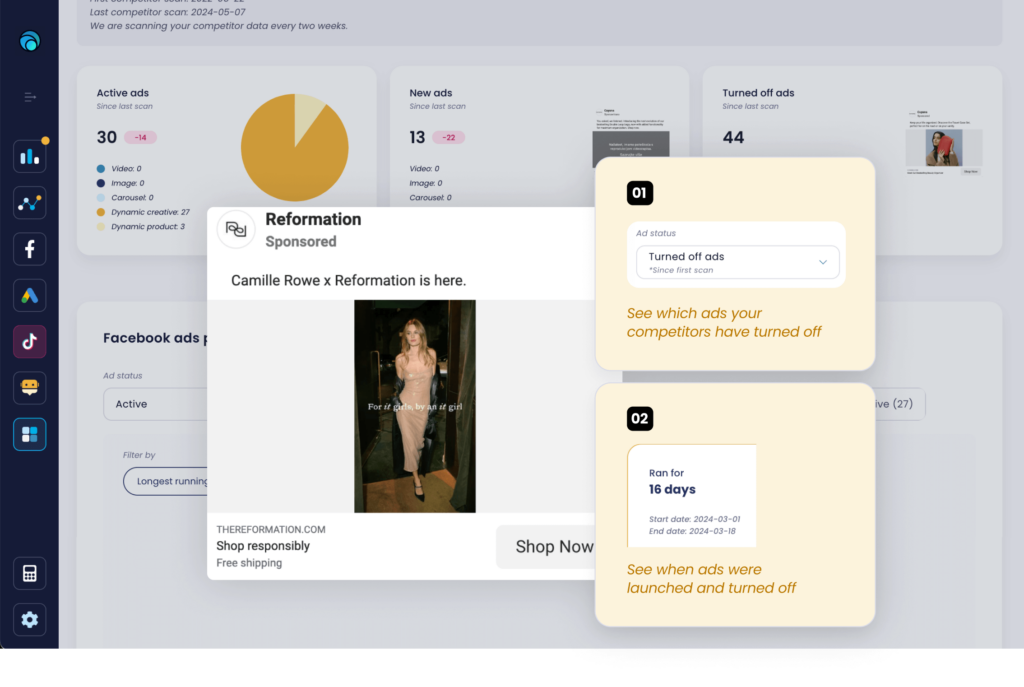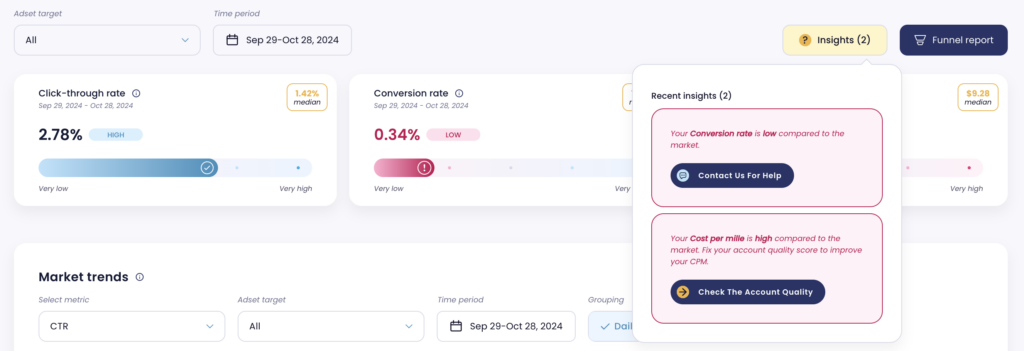Meta Ads continue to be a powerful tool for e-commerce growth. As we move into 2025, adapting to new trends and platform updates is key to maximizing performance.
In this blog post, we’ll break down essential strategies—setting clear goals, optimizing creatives, refining targeting, improving landing pages, and leveraging AI-driven tools.
Are Facebook Ads still worth it in 2025? Let’s find out.
Setting clear Meta ads goal for 2025
In the world of Meta Ads in 2025, setting the right goals is like putting your campaign on the express lane to success. For e-commerce, here’s the golden rule: optimize for purchases, and Facebook’s algorithm will make it a reality.

Here’s the deal – Facebook’s algorithm is pretty smart. Optimizing for purchases is a better strategy than optimizing for traffic because it aligns the campaign with revenue-generating actions rather than merely attracting visitors.
With purchase-optimizing campaigns, you’ll get a higher-quality audience. Optimizing for purchases helps Meta target people who are more likely to buy, not just click, by using purchase behavior data to reach customers inclined to convert.
Meta’s algorithm learns and adapts based on your optimization goals. Choosing purchases as the objective allows Meta to refine its targeting using data from actual buyers, leading to increasingly precise targeting over time.
The purchase-optimized campaigns tend to have higher CPM, but they typically lead to lower CAC because they focus on bringing in revenue, not just traffic.
In short, optimizing for purchases allows your campaigns. to focus on the bottom line, whereas traffic-optimized campaigns may bring a higher volume of visitors but with less intent to convert
Optimize ad content for higher conversions
Next, let’s talk about content optimization.
One significant shift in recent times is the dominance of video ads, influenced by platforms like TikTok. Video content has surged in popularity, reshaping the digital landscape and, in turn, the world of meta ads. But do video ads work better on Facebook or TikTok?
With the influence of TikTok, video ads have become more popular on Meta platforms, but our data suggests image ads might actually be a better choice for budget-conscious brands.
Although video ads show a slightly higher conversion rate at 1.51% compared to 1.49% for image ads, the difference is so small that it’s nearly insignificant.
The real distinction lies in cost: video ads carry a higher CPM, averaging around $7, while image ads are more affordable at about $5. This cost advantage gives image ads a slight edge in ROAS, reaching 159% compared to 144% for video ads.

Interestingly, a new format called flexible ads appears to outperform both traditional image and video ads, blending the strengths of each to achieve even better overall performance.
Meta ads account structure in 2025
So, what’s the best way to structure your Meta Ads account for the best results?
We’ve found that simplifying the ad account setup works best. Our approach focuses on just two main campaigns: one for prospecting and one for retargeting. Additionally, we recommend having only one ad per ad set.
Here’s why this setup delivers results.
One ad per ad set
Using one ad per ad set can be a better approach for several reasons.
First, with a single ad in each ad set, all budget goes toward that ad, ensuring it gets maximum exposure. This avoids budget splitting across multiple ads, which can dilute performance.
Second, when each ad has its own ad set, it’s easier to see which specific ad is driving results. This makes it simpler to optimize by quickly identifying the best-performing ad.
Lastly, one ad per ad set allows straightforward A/B testing across ad sets, as each ad has its own isolated environment to perform without interference from other creatives.
In short, one ad per ad set creates a cleaner, more efficient setup that helps Meta’s algorithm deliver the best possible results for each ad.
Broad targeting
With broad targeting, Meta’s algorithm adapts quickly to performance signals, adjusting who sees the ad based on live data. This flexibility can drive better results, as the algorithm learns which types of users convert over time, rather than relying solely on a pre-defined audience model like a lookalike.
Broad targeting opens up your reach to a larger audience, making it easier to scale campaigns. Lookalikes are limited by the source data size, potentially capping your audience and reach.
Also, Lookalike audiences are more refined but come with higher CPM due to their specificity. Broad targeting has lower CPMs, which can stretch your budget further and drive more impressions.
In summary, broad targeting can provide better results by using Meta’s advanced algorithm, reducing costs, and scaling reach without the limitations of a lookalike audience.
Ad set budget optimization
Ad Set Budget Optimization (ABO) is a strategy for managing budgets within Meta Ads that allows advertisers to allocate specific budgets to individual ad sets instead of a single campaign budget.
ABO gives advertisers detailed control over budget distribution across multiple ad sets, making it ideal for testing, smaller campaigns, or when specific audience targeting is critical. By allocating fixed budgets, advertisers can closely monitor performance and make informed adjustments to maximize their advertising effectiveness.
We recommend using Ad Set Budget Optimization (ABO) because it delivers better return on ad spend (ROAS). Our data shows that ABO achieves an average ROAS of 94% for prospecting ads, while Advantage Campaign Budget (CBO) averages only 81%.
This makes ABO the superior choice for e-commerce businesses aiming to maximize their advertising returns.

Landing page optimization for Meta ads
Next, the landing page. There’s nothing quite as powerful as making sure your landing page seamlessly aligns with your ad.
When users click your ad, they anticipate finding precisely what enticed them in the first place. This means that the content, messaging, and visuals on your landing page must seamlessly align with the ad that brought them there.
It’s not just about keeping users engaged; it’s about guiding them to the final destination – a purchase. By ensuring this seamless connection, you’re not only enhancing the user experience but also significantly increasing the likelihood of conversions.
In 2024, remember that ad relevance to the landing page isn’t just a nice-to-have; it’s an absolute must for Meta Ads success in the world of e-commerce.
The role of optimization tools
Meta is leveraging AI technology, which has become a key part of its advertising features. One of the highlights is the Advertising suite, designed to help advertisers improve their campaign performance.
This suite uses advanced AI tools to analyze data, target the right audiences, and optimize ad placements, ensuring businesses get the most out of their advertising efforts.
With the AI on our mind, it’s time to mention Lebesgue: AI CMO.
Lebesgue is an AI-powered tool focused on optimizing your advertising campaigns by following the latest best practices. It works by comparing your campaigns to industry benchmarks, helping you see where you stand in relation to the competition.
Lebesgue provides tailored optimization advice based on current market trends, making it easier for you to make informed decisions. By using these insights, you can refine your strategies, improve your ad performance, and ultimately achieve better results in a competitive landscape.
Analyzing your competitors on Meta ads
Like in every competitor analysis, first, you need to identify your competitors and their Meta ad strategies. This involves researching what they’re doing with their ads, both currently and over time. By examining their successful, long-running ads, you can gain valuable insights into what works best for them and adapt similar content and strategies for your own ads.
The next step is to put these competitor insights to work. Use successful elements from your competitors’ visuals and ad copy in your own campaigns. In our experience, this approach has yielded remarkable results.
With the help of Lebesgue: AI CMO, we achieved a remarkable 52% increase in ROAS and a significant 38% reduction in the CAC. These tests were done on prospecting campaigns, highlighting the potential for success when applying competitor strategies to your ads.

Summing up
There you have it—essential insights to supercharge your Meta ads in 2025. We trust that these strategies will guide you toward optimal campaign performance and remarkable results. But remember, the world of advertising is dynamic, and staying ahead requires adaptability.
Don’t forget, if you need any help with optimizing your campaigns or creating them give Lebesgue a try.




